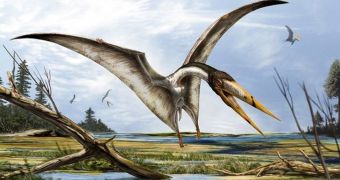Every once in a while, your regular Joe or Jane wakes up in the morning only to find that the only thing on their mind is where on Earth the nearest ancient flying reptile remains might be.
The good news is that, thanks to paleontologist Matthew McLain, now a doctoral student at Loma Linda University in California, US, the answer to this most pressing question is now just a few clicks away.
Thus, a recent paper in the journal Historical Biology details how, together with his colleagues, Matthew McLain has developed a website that allows users to map extinct flying reptiles on Google Earth.
The website in question is dubbed PteroTerra, and it currently catalogs over 1,300 pterosaur specimens scattered all around the world. It is intended to make it easier to study both the evolution and the diversity of these ancient creatures.
According to Live Science, pterosaurs roamed the Earth between 228 million and 66 million years go. They came in all shapes and sizes, meaning that some were about as small as modern sparrows, whereas others were as big as giraffes.
In a statement, Matt McLain explains that, although paleontologists are no strangers to databases documenting the location of various fossils, the fact remains that the databases created thus far tend to be a tad too complex.
The doctoral candidate considers this to be a problem and argues that, all things considered, less complex databases that aim to be as specific as possible can only come in handy when researching how our planet's biodiversity has transformed over the years.
“Having a very specific database like this, which is just for looking at individual fossil specimens of pterosaurs, is very helpful, because you can ask questions that you couldn't have answered with bigger databases [of more animals],” the doctoral candidate argues.
In order to create PteroTerra, Matt McLain had to read available studies concerning pterosaurs and visit museums where fossilized remains belonging to such creatures are on display. The doctoral candidate argues that, although thousands of remains are yet to be cataloged, he is quite proud of his work.
More so given the fact that he has already been contacted by several researchers and paleontology enthusiasts who hope to create similar websites to document the distribution of fossilized remains belonging to other ancient species.
Besides, Matt McLain says that he is looking into the possibility to create a database documenting whatever dinosaur footprints and tracks have until now been uncovered across the globe. One such database would help shed new light on what these ancient beasts were up to in their heydays.

 14 DAY TRIAL //
14 DAY TRIAL //